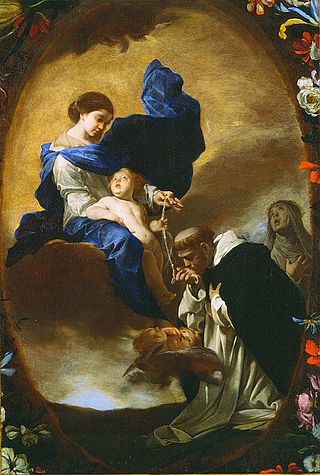
The Rosary, formally known as the Psalter of Jesus and Mary, also known as the Dominican Rosary, refers to a set of prayers used primarily in the Catholic Church, and to the physical string of knots or beads used to count the component prayers. When referring to the prayer, the word is usually capitalized ; when referring to the prayer beads as an object, it is written with a lower-case initial letter.

The Angelus is a Catholic devotion commemorating the Incarnation of Christ. As with many Catholic prayers, the name Angelus is derived from its incipit—the first few words of the text: Angelus Domini nuntiavit Mariæ. The devotion is practised by reciting as versicle and response three Biblical verses narrating the mystery, alternating with the prayer "Hail Mary". The Angelus exemplifies a species of prayers called the "prayer of the devotee".
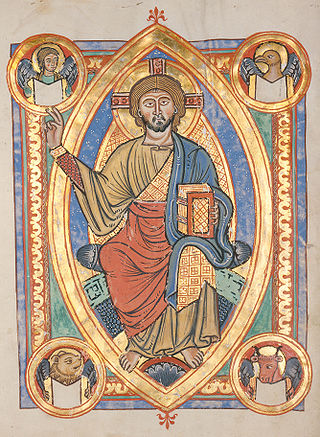
In Catholic tradition, the Five Holy Wounds, also known as the Five Sacred Wounds or the Five Precious Wounds, are the five piercing wounds that Jesus Christ suffered during his crucifixion. The wounds have been the focus of particular devotions, especially in the late Middle Ages, and have often been reflected in church music and art.
Vexilla regis prodeunt is a Latin hymn in long metre by the Christian poet and saint Venantius Fortunatus, Bishop of Poitiers. It takes its title from its incipit.

The "Salve Regina", also known as the "Hail Holy Queen", is a Marian hymn and one of four Marian antiphons sung at different seasons within the Christian liturgical calendar of the Catholic Church. The Salve Regina is traditionally sung at Compline in the time from the Saturday before Trinity Sunday until the Friday before the first Sunday of Advent. The Hail Holy Queen is also the final prayer of the Rosary.
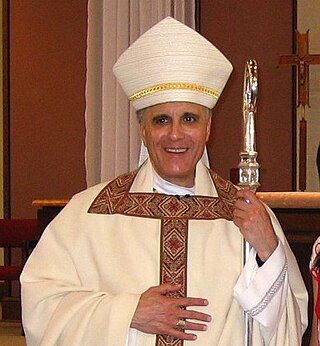
Daniel Nicholas DiNardo is an American cardinal of the Catholic Church. He is the second and current archbishop of the Archdiocese of Galveston-Houston in Texas, serving since 2006. He previously served as coadjutor bishop and bishop of the Diocese of Sioux City in Iowa from 1997 to 2004.

The Great Cross of Hendaye is a stone cross located on the town square of Hendaye, in the Pyrénées-Atlantiques, in southwestern France. The cross includes references to apocalyptic beliefs about Christianity, Rosicrucianism, and alchemy. Many, including devotees of Nostradamus, the Bible Code, and especially the 2012 phenomenon, believed that a great comet would pass by, or crash into the earth in the year 2012, and interpreted the Cross of Hendaye as another reminder that 2012 would be the end.
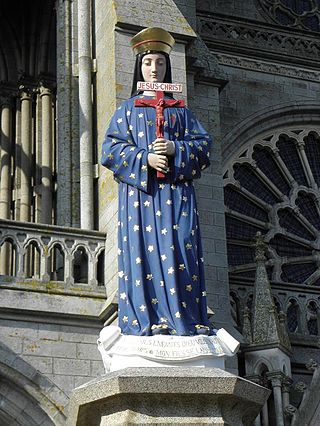
Our Lady of Pontmain, also known as Our Lady of Hope, is the title given to the Virgin Mary following her apparition at Pontmain, France on 17 January 1871.

Minor Basilica of the Immaculate Heart of Mary, is a titular church in Piazza Euclide, Rome. It was built by the architect Armando Brasini (1879–1965). Its construction began in 1923 with the design of a Greek cross inscribed in a circle with an articulated facade, and completed before 1936, the year in which it was made a parish church and granted to the Congregation of Missionary Sons of the Sacred Immaculate Heart of Mary, usually known as the Claretian Missionaries. A grand dome was planned, but never realized; a smaller drum was completed in 1951.
Giuseppe Mori was an Italian cardinal of the Roman Catholic Church. He served as secretary of the Sacred Congregation of the Council from 1916 until his death, and was elevated to the cardinalate in 1922.
Holy Cross High School is a Catholic High School in Hamilton, South Lanarkshire, in Scotland.

"Hail, Queen of Heaven, the Ocean Star" is a Marian hymn written by Father John Lingard (1771–1851), a Catholic priest and historian who, through the works of William Cobbett, helped to smooth the passage of the Catholic Emancipation Act in England.
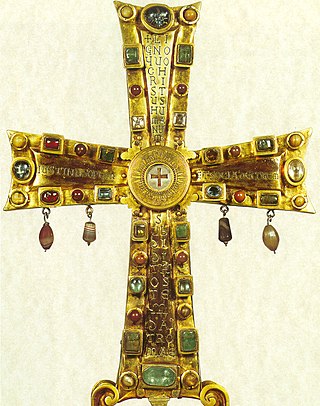
The Cross of Justin II is a processional cross dating from the sixth century that is kept in the Treasury in St. Peter's Basilica, in Vatican City. It is also one of the oldest surviving claimed reliquaries of the True Cross, if not the oldest. It is a crux gemmata or jewelled cross, silver-gilt and adorned with jewels in gold settings, given to the people of Rome by the Emperor of the Eastern Roman (Byzantine) Empire, Justin II, who reigned from 565 to 578 in Constantinople, and his wife, the Empress Sophia.

The Christian cross, seen as representing the crucifixion of Jesus, is a symbol of Christianity. It is related to the crucifix, a cross that includes a corpus and to the more general family of cross symbols. The term cross is now detached from its original specifically Christian meaning, in modern English and many other Western languages.

Monmouth Cemetery is a cemetery located at Osbaston Road, Monmouth, Wales. It was available for burials between 1852 and 2012.
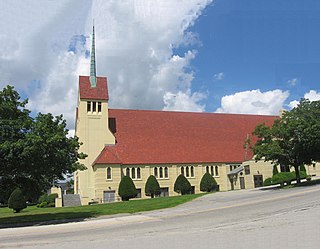
Holy Cross Church is a church at 1080 Lisbon Street in Lewiston, Maine and is part of the Roman Catholic Diocese of Portland.

The Trinity Carol Roll is a 15th-century manuscript of thirteen English carols held by the Wren Library at Trinity College, Cambridge. It is the earliest surviving example of polyphonic music written in English. Compiled after 1415, it contains the earliest of two manuscript sources for the Agincourt Carol which tells of Henry V's victory at the Battle of Agincourt, as well as several early Christmas carols. The majority of texts are in Middle English with some of the carols alternating between Latin and Middle English, a common form for carols of the period known as macaronic.

The Extraordinary Jubilee of Mercy was a Catholic period of prayer held from 8 December 2015, the Solemnity of the Immaculate Conception, to 20 November 2016, the Feast of Christ the King. Like previous jubilees, it was seen by the Church as a period for remission of sins and universal pardon focusing particularly on God's forgiveness and mercy. It was an extraordinary Jubilee because it had not been predetermined long before; ordinary jubilees are usually celebrated every 25 years.

"Sonne der Gerechtigkeit" is a German Christian hymn with a complex history. The image of a sun of justice or righteousness was created by the prophet Malachi. The text was compiled around 1930 by Otto Riethmüller from older stanzas by different hymnwriters, intended as a wake-up call to the church in a Germany facing the rise of the Nazis. Four of its originally seven stanzas were written in the 18th century, two by Johann Christian Nehring, and two by Christian David. The remaining stanzas were taken from Christian Gottlob Barth, written in the 19th century. An alternative seventh stanza was suggested in 1970, with a strong ecumenical focus. The hymn expresses a call for justice, renewal and unity, within the congregation and church, and among peoples.

The Bell Tower is situated on the University of Portland campus in Portland, Oregon, United States. Built during late 2008 and early 2009 at a cost of $1.3 million, the brick tower houses fourteen bells that ring the hours and chime music. It is topped with a glass-reinforced concrete cupola and cross made of brushed stainless steel. It is the university's tallest structure at 95 feet (29 m), and has been the site of vigils and on-campus demonstrations.

















